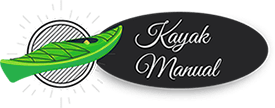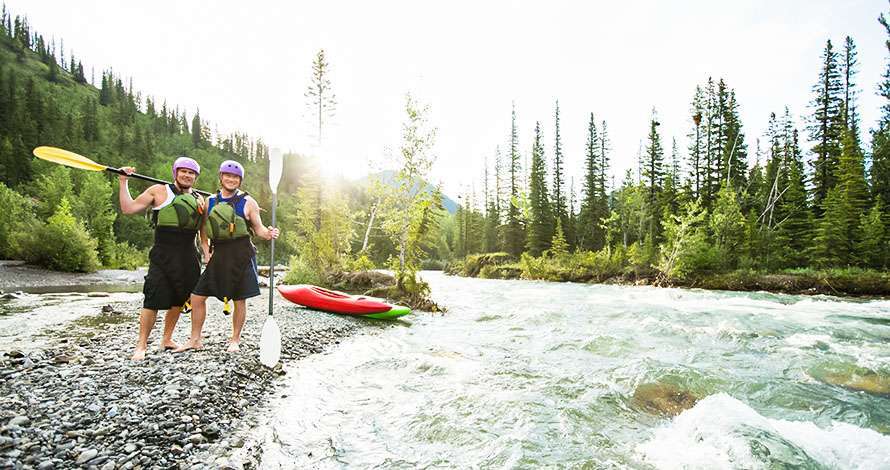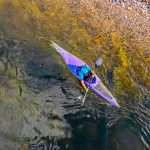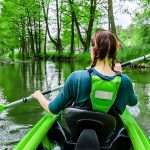The foreword sweep is the building block of all kayaking strokes. There are three sweep variations an intermediate/advanced paddler should know and practice: the stern draw (last half of full sweep), the full sweep and the aggressive sweep. Let’s look at each and study where and when each is most effective.
1. Stern draw
Sweeps to control the stern of your boat are most important when you are learning to go straight, ferry and surf. For these moves, you’ll want sweeps that finish with a stern draw. Follow the blade with your torso and eyes. This will give you good strength for the stroke, and helps ensure the blade position of a wide stern draw with the blade anchored.
Even the most advanced paddlers use the stern draw at the back of the boat when surfing a steep/fast wave, or when trying to hold their downstream angle as they dive across an eddy.
Choose the stroke that uses the water. Some of the least effective strokes happen when a paddler tries to correct a ferry with a sweep at the bow. Controlling your boat angle on a ferry or surf is an ideal time for a stern draw.
Practice your stern draw. Rotate your torso, and finish with your front hand high before your face to ensure the blade goes deep in the water at the correct angle to anchor the blade. Practice the stroke watching the blade. Once you get the blade angle correct, practice the stroke looking forward. A good drill: let the boat fall off a ferry angle, then correct with a stern draw, squeezing the blade gently to the stern.
A common mistake is to correct a boat angle with a sloppy stroke that lifts water at the end. To correct this problem drop your back elbow, and get the front hand high. Watch the blade for feedback until you always get it right! A stern draw with good technique will make corrections easy!
2. Full Sweep
Practice a forward sweep following the blade with your eyes, head and torso. Again, take the blade in a wide arc. With this sweep you might take in an arc further to the stern, ending in a stern draw. You’ll get the best results from a quiet stroke without splashes.
As you practice, do the sweep with your boat flat. Keep it steady without wobbles. Even a small amount of edging or wobbles will reduce the efficiency of the turn.
When working on your sweep strokes, think of a rounded-off rectangle, rather than a half circle–out from the boat, parallel to the boat, and back into the boat. This will maximize the sweep’s power. This full sweep/stern draw combo will help you practice anchoring the blade in the water without rushing or splashing. This sweep, combined with a reverse sweep, is most effective to get you straightened out when you get turned backwards.
3. Aggressive sweep
In the aggressive sweep the key is to focus your eyes and chest in the direction you wish to turn. This anticipation with your eyes, head and torso is one of the key elements for powerful and precise boat placement, and is used frequently in playboating. An ideal use of this “preturn” of the torso and forward sweep is when completing the second half of flat spins.
For cartwheels, this torso movement is extra important. Your body needs to stay ahead of the boat by leading with your head, torso and blade. If your body lags behind the boat then you will typically lose your balance and fall over.
Aggressive sweeps at the bow are also valuable when heading down a river or arcing down across current. In some of these cases, any stroke near the stern is wasted effort.
Practice leading with your head and chest, so that your body finishes in the neutral position. When you start a sweep, start with a push away from the bow. Think of pushing your feet away from the blade. Anchor the blade! Check that the blade gets at least three feet from the boat, with a nearly horizontal shaft. Taper off the power on this sweep as you sweep into your hip.
Don’t worry if this aggressive technique is a little different from the sweeps you first learned. It’s simply a more advanced technique.
Pick Your Sweep
Most paddlers agree: finesse and quality strokes are important in paddling, but all too often on the river we simply pull harder to turn. If you find yourself in a flurry of correction strokes, the odds are you’re trying to out-muscle the river. It’s important to slow down so you can take higher-quality strokes.
Lead a sweep with your head and chest for aggressive, proactive moves like flat spins and cartwheels. Follow the stern draw with your torso, and perhaps eyes when you are reactive, like spinning a full circle, or correcting a ferry, or adjusting a surf.
Each sweep has its own benefits. Remember to practice good stroke quality for each type so that you will get the full benefit from each one.
Last modified: March 12, 2022


